Flightline RC B-24 Liberator 2000mm
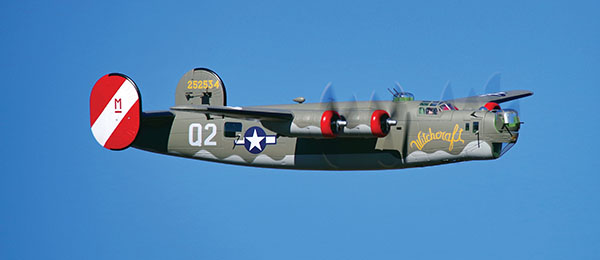
Written by Jon Barnes Large, electric, heavy bomber is available in two color schemes. Product Review As seen in the February 2018 issue of Model Aviation.
Bonus Video
Specifications
Model type: Multiengine electric warbird Skill level: Intermediate Wingspan: 78.7 inches Wing area: 543 square inches Length: 48.4 inches Weight: 77 ounces Power system: Four 3530-860 Kv brushless outrunner motors; four FlightLine RC 30-amp ESCs (included) Radio: Minimum six-channel required Construction: EPO foam Price: $429Test-Model Details
Motor used: Four FlightLine RC 3530-860 Kv brushless outrunners Speed controller: Four FlightLine RC 30-amp ESCs; external 8-amp BEC Battery: Two Admiral 35C 4S 14.8-volt 3,000 mAh LiPos Propellers: Three-blade 9.5 x 7 Radio system: Spektrum DX9 DSMX transmitter; Spektrum AR9020 DSMX receiver Ready-to-fly weight: 99 ounces Flight duration: 5 to 10 minutesPluses
• Available in silver or green paint schemes. • Includes two different magnetically retained noses, allowing pilots to create both D and J variants. • The upper turret (and Emerson nose turret on the J variant) can be rotated in flight using a servo. • Satisfyingly large 2,000mm wingspan. • An FPV camera can be mounted in the turrets. • Large diameter, tricycle configuration landing gear makes for easy operation from less-improved runway surfaces.Minus
• No factory-installed LED navigation or landing lights are included.Product Review
Pilots, with their preferences squarely rooted in scale military aircraft, typically have no shortage of new models from which to select each year. Most warbird models that are released represent the more popular, propeller-driven, piston-powered, single- and twin-engine fighters flown throughout history. Those interested in models of the much heavier—and usually substantially less-maneuverable—bombers used by the world’s air forces of yesteryear typically find themselves limited to a meager selection of models. When manufacturers bring electric-powered, foam-composition bombers to market, the focus is almost always on bomber aircraft powered by two engines and not the potentially more costly and more complicated four-engine heavy bombers. With those market realities summarized, Motion RC’s surprise announcement of the release of what I believe to be the first-ever, electric-powered, EPO foam-composition Consolidated B-24 Liberator is sure to have pilots surprised, stunned, and perhaps even speechless, with excitement. When doing the homework to design and deliver this model to scale aircraft aficionados, Motion RC obviously adhered to the belief that bigger always flies better. With a relatively massive 78.7-inch wingspan, this model B-24 is approximately a 1/16-scale replica of the real deal. The first decision faced by pilots who are poised to purchase this big bomber is whether they prefer a silver or green color scheme; the model is offered in both. It is worth noting that the green version pays homage to the only B-24J in the world currently restored to flying condition. The full-scale Collings Foundation’s Consolidated B-24J Liberator depicts the original Witchcraft scheme, which flew a record 130 missions over Europe. Although the restoration’s initial goal was to create a museum-quality static model, the foundation later decided to exhaustively restore the B-24 to full flying status. As a part of the Collings Foundation’s Wings of Freedom Tour, it annually visits more than 120 cities and offers those especially passionate about historical aviation the option to purchase a 30-minute ride! The B-24 Liberator includes flaps, retractable landing gear, and ample scale details. Pilots can select from two different magnetically retained nose sections (a greenhouse nose or an Emerson turret nose), effectively allowing this model to present itself as either a B-24D or B-24J variant. Motion RC mentions in the assembly manual’s introductory material that the foam composition airframe is reinforced with carefully integrated pieces of aluminum, carbon fiber, and plastic. A minimum six-channel radio system is required, although pilots interested in exploring the model’s rotatable turrets and FPV capabilities might need to use a system with a few extra channels. The preinstalled four pack of brushless power systems are fed by a pair of four-cell 14.8 volt 2,800 to 4,000 mAh LiPo batteries, with one battery driving the inboard engines and the second one responsible for the outboard engines. Configured as such, a battery failure and resultant feathering of two opposing motors is not necessarily a death knell for this model. The B-24 is touted as being fully capable of limping back to the runway with only two of its four motors operational, although pilots are advised to keep the throttle pushed to the stops!Assembly
Aircraft assembly is 100% glueless. With the insertion and tightening of a mere 12 fasteners, pilots will have a fully assembled B-24 Liberator sitting on their bench in short order. A pair of round carbon-fiber spars is used to strengthen the center section of the long, narrow-chord wings and structurally tie them into the fuselage. All wing functions, including ailerons, flaps, throttle, and landing gear, are aggregated into a multipin connector. Plastic hinges are used on the ailerons, with the long inboard flaps using foam hinging. The wing connectors plug into a control board that is mounted in the fuselage near the center of gravity.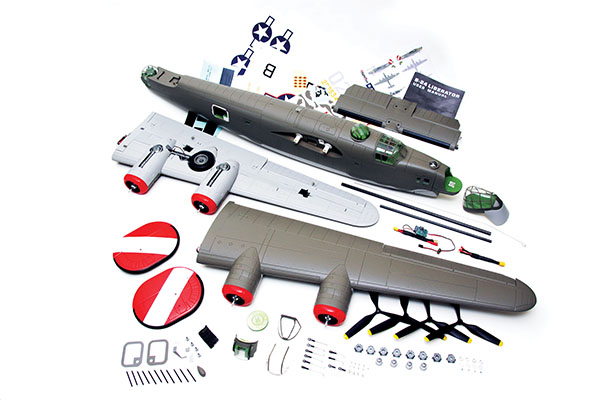
Although assembling the primary airframe is 100% glueless, attaching the assortment of included scale details will require adhesives.
The power leads of the ESCs must be routed into the fuselage when mounting the wing halves. FlightLine RC uses two sizes of bullet connectors and opposing genders on the ESC power leads, simplifying and virtually bullet-proofing the process of connecting the inboard motors to one ESC and the outboard motors to the other. An external 8-amp BEC is connected to one of the battery connectors (XT60 style). In theory, the loss of one battery in flight—and by extension, the two motors connected to it—offers a certain level of redundancy and should enable the B-24 to continue flying and execute an emergency landing. If the battery that fails is the one that the BEC is connected to, the receiver will go dark. The entire tail section assembles with fasteners. Plastic-style hinges are used on both rudders and elevators. The twin rudder servo leads are almost completely hidden. They are routed inboard through an internal channel that is molded into the horizontal stabilizer. After the tail is assembled and mounted to the fuselage, all four servo leads must be routed forward. FlightLine RC commendably outfits the twin rudder and elevator servos used on the B-24 with extra-long leads. Minimizing the number of servo extensions used in a model is a good thing because each connection between the servo and the receiver is ultimately a potential source of failure. Routing the long servo leads from the empennage forward through the long slender fuselage is easy thanks to the included steel wire hook tool.
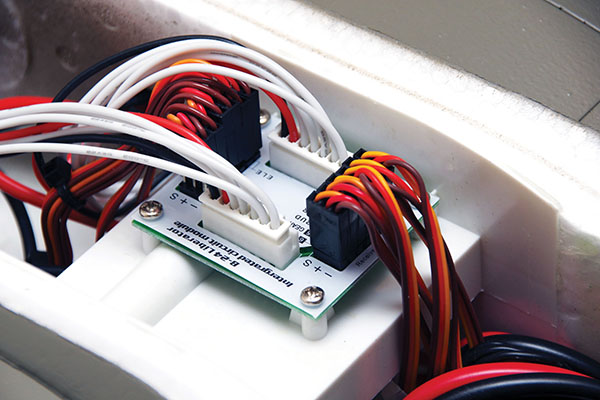
The included control board greatly simplifies the process of removing the wings for transport and storage.
The balance of the assembly involves attaching the variety of plastic scale accessories included in the box. Pilots must source and use an appropriate adhesive. The arsenal of black plastic gun barrels included in the kit must all be glued into their respective places on the airframe. As noted before, pilots can choose which nose structure to use on their B-24. The Emerson gun turret-equipped nose used on the B-24J must first be assembled. Because the entire nose assembly is magnetically retained, pilots can switch between the two noses at will. FlightLine RC mentions in the assembly manual that the rotatable Emerson nose turret and upper turret offer FPV pilots two locations into which they can mount a small camera. Both turrets include a tiller arm and can be rotated in flight using an optional servo. The final assembly step is to apply the included waterslide graphics to the airframe.
Flying
Before the first flight, this four-engine bomber requires the pilot to perform throttle calibrations for each pair of ESCs. Best safety practices dictate removing all four propellers before doing this. The calibrations ensure that all four power systems are fully synchronized and humming along in harmony. Failure to perform this initial calibration could result in a model that demonstrates adverse yaw characteristics with changes in the power settings. Although the full-scale B-24’s propellers all rotate in the same clockwise direction (as viewed from the cockpit), this model uses opposed pairs of counter-rotating propellers to help minimize the negative effects of excessive torque. (The right pair spin clockwise and the left pair spin counterclockwise).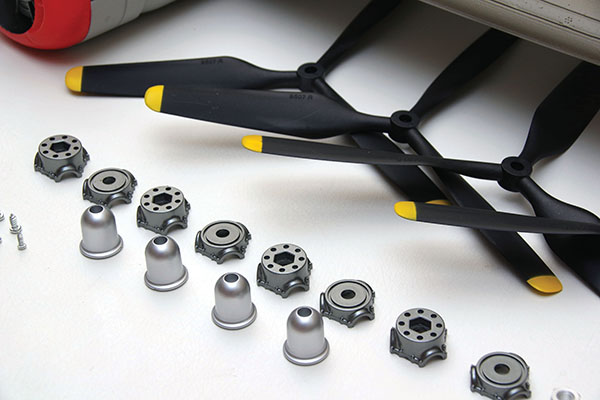
Although the full-scale Liberator propellers all rotate in the same direction, FlightLine RC minimizes potential adverse yaw effects by configuring the four, three-blade propellers to counter-rotate.
The preflight fine print in the assembly manual also suggests that pilots add in 1.5mm of up-elevator trim and small amounts of flap-to-elevator mixing for both of the factory-recommended takeoff and landing flap positions. Utilizing a programmable transmitter with flap speed setting (if so equipped) to slow the flaps to a more scalelike rate of deployment and retraction will help to minimize unwanted and sudden pitch changes when transitioning into the landing pattern. The scale-looking tricycle landing gear used on this model closely replicates the gear used on the full-scale B-24. The large-diameter tires (85mm for the mains and 70mm for the nose gear) are sure to work wonders for pilots planning to fly their B-24 from grass airstrips. When compared with the inherently more challenging ground manners of the tail-dragger-equipped cousin of the Liberator, the Boeing B-17, the B-24’s ground manners are superlative.
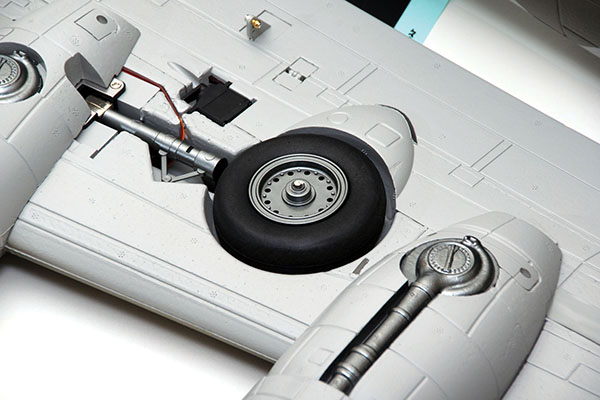
The large-diameter tricycle landing gear gives the B-24 the ability to operate from less-improved runway surfaces.
The B-24 offers no surprise endings when executing landings and takeoffs. Tracking in the takeoff roll is straight and steady. The four brushless outrunners make a bunch of thrust and give this model plenty of power. Although it is certainly capable of racing through the skies in a speedy manner, fighter-style flying is not really this model’s forte. More sedate throttle settings work best and allow a pilot to fly this big bomber in a convincingly scalelike manner. Pilots should be prepared to add a moderate amount of rudder in the turns to keep the model tracking properly through the air. Big sky loops and slow, graceful rolls can easily be executed. The abundance of guns bristling from every corner of the airframe, the Witchcraft graphics scheme, and the impressive level of detail combine to create a model that is absolutely stunning in flight! The long, tapered wing generates a lot of lift and can contribute to the model feeling slightly floaty on final approach. One feature that some pilots might find conspicuously absent from this B-24, however, is the inclusion of factory-installed navigation strobes and landing lights. The first few flights were flown using a pair of Admiral 4S 3,000 mAh LiPo battery packs. After it was trimmed, the big bomber was surprisingly neutral when flown inverted. Subsequent flights were flown using slightly larger and heavier 4S 4,000 mAh batteries. With these heavier packs placed to the front of the battery bay, the B-24 felt more locked in and less floaty. When flown on the larger batteries, 6-minute flight durations with varied throttle settings saw the batteries depleted to slightly more than 50%. With a light hand on the throttle, pilots should have no problem eking out flight durations of up to 10 minutes! A wing cube loading number of 13.9 places this model squarely in the scale genre of aircraft.
Conclusion
Optional upgrades on the radar and soon to be made available for this model, include an exquisitely detailed 3-D printed cockpit, suspension-equipped struts, and a nose gear door option. A variety of alternative graphics schemes will be available from Callie Graphics.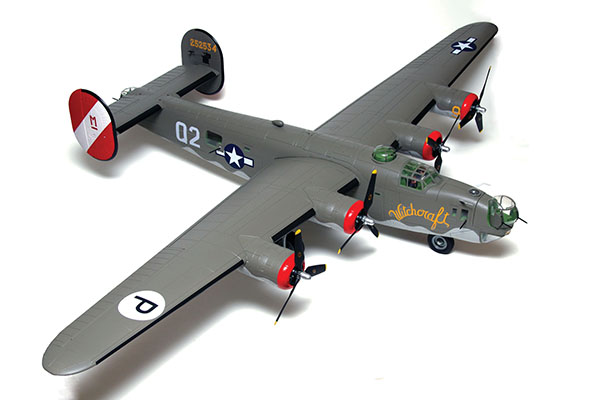
The airframe arrives in a prepainted green/gray, red, and white color scheme. Pilots can opt to apply the included waterslide Witchcraft graphics or source one of several custom vinyl graphics schemes available from Motion RC’s partner, Callie Graphics.
Longer-than-average flight durations and an impressive array of customization options allow pilots to make their B-24 stand out on the ramp and in the air. With Motion RC’s release of the FlightLine RC 2000mm Wingspan Consolidated B-24 Liberator, pilots who have yearned to join the four-engine model club now have an elegant and historical way to realize their dream. —Jon Barnes [email protected]










1 comments
B-24
Add new comment